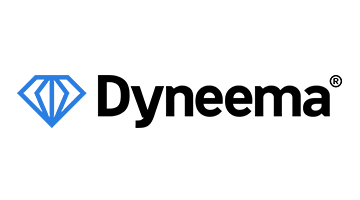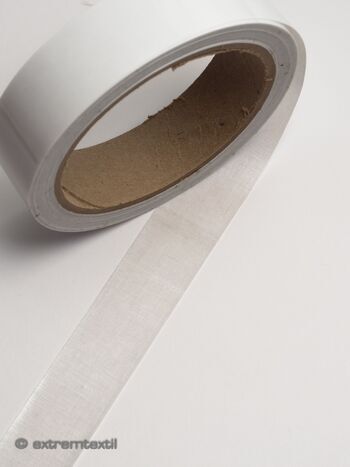
Len
Dyneema®, the world's strongest fiber™!
With the marketing slogan "The world's strongest fiber," Avient, the manufacturer of Dyneema®, is going out on a limb. In our opinion, rightly so! Because to date, no other organic fiber has surpassed the tear resistance of Dyneema®. And when it comes to abrasion resistance, UV stability, kink resistance, and chemical resistance, it also outshines many other fibers:
- 15 times stronger than steel on a weight basis (to be more precise: 15 times stronger than soft steel, 3 times stronger than high-strength steel and versatile for textile applications) and therefore extremely tear-resistant with low weight
- 40% stronger than aramid fibers by weight
- Very high resistance to most chemicals
- Cold stable down to -150°C (however, only heat stable up to 70°C on a permanent basis)
- Does not absorb water, so its technical properties are not affected by moisture
- Extremely low elongation at break – does not stretch under load
- Highly resistant to kinking
- Lighter than water
What is Dyneema®?
First and foremost, it's the name: Dyneema® is the brand name for UHMW-PE fibers from Avient, a global manufacturer of innovative materials based in the Netherlands. Avient acquired these trademark rights in 2022 from DSM, which has been instrumental in the development of Dyneema® and UHMW-PE fibers since the 1960s. Along with the trademark rights, Avient also acquired expertise in production and materials science, with production sites in the US, Europe, Singapore, and China. Dyneema® fibers are produced entirely in-house at one of the four locations. Avient is one of the few manufacturers that already produces the polymer for its UHMW-PE itself, which ensures seamless quality control and traceability. Dyneema® fibers are processed in-house or by a widespread network of reliable partners into fabrics, composites, ropes, tapes, and much more.
And what is UHMW-PE?
The abbreviation UHMW-PE stands for Ultra High Molecular Weight Poly Ethylene, a special form of polyethylene. Polyethylene is probably familiar to everyone, as it is a plastic that is widely used in packaging, appliances, films, and even in our sheet products. However, the difference lies in the chemical structure of the polyethylene: in the everyday applications mentioned, LD-PE (low density) or HD-PE (high density) is generally used, depending on the strength of the product. The different properties are achieved by using shorter or longer molecular chains. Longer chains give the material greater strength. In UHMW-PE, these molecular chains are extended to their technical feasibility, resulting in a very high molecular weight (ultra-high molecular weight). This structure is particularly good at absorbing and distributing tensile loads, resulting in this special type of polyethylene with its outstanding properties.
What makes Dyneema® so special?
With its long tradition and strong brand, Dyneema® is the leader when it comes to fibers and composites made from UHMW-PE. Thanks to the complete production process from polymer to fiber under one roof, maximum quality is always guaranteed. Since UHMW-PE can have different properties depending on the manufacturing process, it is advantageous if these properties are clearly visible. For this reason, various grades of Dyneema® have been developed that are optimized for different applications.
The Dyneema® grades
There are currently over 40 different Dyneema® grades for a wide range of applications. For lifting loads, sailing, fabrics, composites, medical applications, cut protection, and even ballistic applications. These styles are often used for outdoor, sports, and technical textiles:
SK75: Long-standing standard with multi-purpose properties
SK78: Standard grade with the same strength as SK75, but significantly improved creep behavior
SK99 (since 2013): 20% strength advantage over SK78 with the same elongation/creep properties
What are the applications for Dyneema®?
The applications for Dyneema® are very versatile. Dyneema® fibers are optimized for a wide range of applications to ensure optimal performance in the following areas:
- Fabrics made from 100% Dyneema® or in blends with other fiber types such as nylon, polyamide, polyester, elastane/Lycra, coated or uncoated, as ripstop, taffeta, or jersey, etc. (Dyneema® Wovens product group)
- Dyneema® Max Technology for ropes and rigging in water sports
- Nets, from fishing nets to lightweight nets on bags (product group Dyneema® Knits)
- Composites, e.g. Dyneema® Composite Fabrics (product group Dyneema® Composites)
- Cotton denim fabric with Dyneema®, with or without elastane/Lycra (product group Dyneema® Denim)
- Dyneema®-reinforced leather for shoes, etc. (product group Dyneema® Bonded Leather)
- Dyneema®/carbon fabric (product group Dyneema® Carbon)
- Dyneema® Diamond Technology for cut protection in work gloves and cut-resistant clothing
- Dyneema® for stab protection and ballistic protection
- Sewing threads made from Dyneema® with extremely high strength and low stretch, UV-resistant
- Webbing made from Dyneema® with extremely high strength and low stretch
How sustainable is Dyneema®?
Like all UHMW-PE fibers and synthetic fibers, Dyneema® is made from petrochemical raw materials, which is of course not sustainable in itself. However, Avient strives for the most sustainable production chain possible in its sourcing and production:
Greenhouse gas emissions
Avient has set itself the goal of reducing greenhouse gas emissions by 55% by 2030. By 2050, production should be climate neutral.
Oeko-Tex®
The production facilities for Dyneema® fibers are certified according to the Oeko-Tex® Standard 100. Whether the final product complies with Oeko-Tex® depends on further processing and fabric production by partners. Only if all further production steps are carried out in Oeko-Tex®-certified production facilities and only certified materials and additives are used can the final product be Oeko-Tex®-certified.
Recycling
In addition to traditional production from petrochemical raw materials, Dyneema® is manufactured in two different recycled variants:
- Dyneema® fiber from bio-circular raw materials (formerly "Bio Based Dyneema®"). This process was developed by DSM, with commercial production starting in 2020. Currently (2025), Dyneema® is the first and only UHMW-PE produced from bio-based raw materials. Bio-Circular Dyneema® uses ethylene from residues from the wood and pulp industry. The raw material is available in large quantities and would otherwise be disposed of as waste. Bio-Circular Dyneema® therefore does not use any agricultural land or disrupt food value chains. This manufacturing process reduces the carbon footprint to approximately 1/5. Bio-Circular Dyneema® has the same technical properties as Dyneema® from conventional production.
- Dyneema® fiber from recycled raw materials (circular raw materials). Production waste or other waste is recycled for this purpose.
- Both variants are certified according to International Sustainability and Carbon Certification (ISCC).
Recyclability
Dyneema® in its pure form is recyclable. However, the problem is that Dyneema® is often processed together with other yarns or materials. Separating these mixtures back into their pure forms is currently still very difficult and costly. Avient and an entire recycling industry are working on solutions here.
Durability as an aspect of sustainability
- Service life: The longer a material can be used, the more resource-efficient it is. With its outstanding tear and abrasion resistance properties, Dyneema® extends service life, even in demanding applications.
- Transport: The addition of Dyneema® makes materials lighter, requiring less fuel and storage space for transport.
- Microplastics: Thanks to their high strength and smooth surface, high-quality Dyneema® fabrics release fewer microplastics.
- BUT: Dyneema® can be used to produce very lightweight fabrics. In the ultralight sector in particular, it is tempting to save every last gram and use a fabric that is too weak. In the worst case, the product will end up in the trash much faster. It is important to weigh up the benefits, durability, and sustainability.
Does Dyneema® also have disadvantages?
Despite all its outstanding properties, Dyneema® unfortunately also has a few disadvantages that you should be aware of when using it. Of course, these disadvantages do not only apply to Dyneema®, but also to all other products made of or containing UHMW-PE:
- Low knot strength: This property applies to cords, strings, and ropes made of UHMW-PE in general. Knots can reduce the breaking load of a cord by up to 35%.
- Smooth, slippery surface: Since Dyneema® is very smooth, knots, cord stoppers, or line tensioners can easily slip on cords or buckles. For cords, a polyester sheath can help. For webbing, weaving in polyester or nylon helps.
- Low stretch: What is an advantage in many cases can also have disadvantages. Fabrics or composites with Dyneema® do not distribute the load at anchor points as well as slightly more elastic fabrics such as Silnylon. Static cords do not act as light tension dampers when used as guy lines.
- Sewing threads are significantly more difficult to sew with a sewing machine than polyester threads.
- Due to its smooth surface, fabric with Dyneema® is difficult to coat. However, many manufacturers have now found durable solutions for this.
- Low temperature resistance: Fibers made of UHMW-PE should only be used at temperatures up to +70°C. During processing, temperatures should not exceed +90°C.
- Dyeing: Due to its high molecular density and low temperature resistance, Dyneema® is difficult to dye. Colors are often not as vibrant as with other materials.
- Price: Materials made from and with Dyneema® and UHMW-PE come at a price due to the high production costs. But in return, you can use them to make very high-quality, durable products that you can enjoy for a long time. There are now many other products made from unbranded UHMW-PE that we have had very good experiences with and therefore also carry in our range. With Dyneema®, however, you can always be sure of getting a high-quality and durable product.
Using Dyneema® as a brand
Are you a small or large brand and want to get started with your Dyneema® products? Congratulations! But please note: In order to legally use Dyneema® in product names, a signed and valid trademark license agreement with Avient is required. This agreement can only be made directly with Avient. If necessary, we will be happy to put you in direct contact with them.
Our products with Dyneema®
Want to finally get started with Dyneema® and looking for the right material for your next project? As a distribution partner of Avient, we have a wide range of materials with original Dyneema® in our product range. You can find a detailed overview on the Dyneema® info page. Or you can use our material filter in the shop categories. There you can filter specifically for Dyneema®.
Dyneema® and Dyneema®, the world's strongest fiber™, are trademarks of Avient. Use of these trademarks is prohibited without express permission.
























